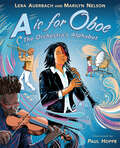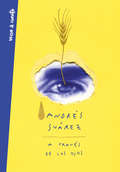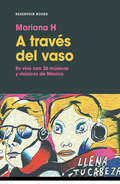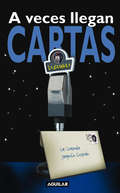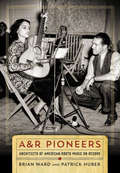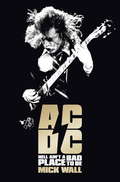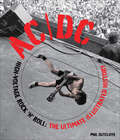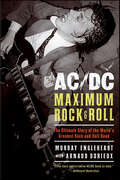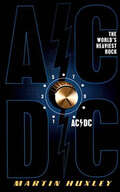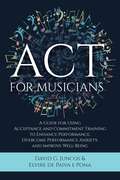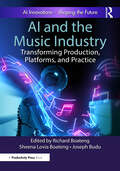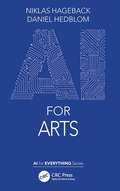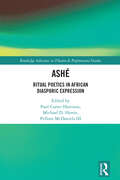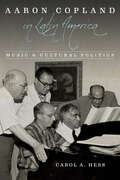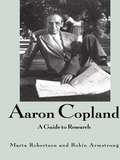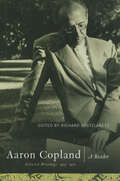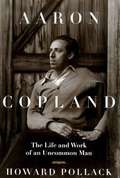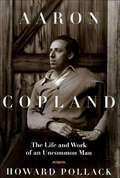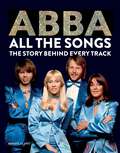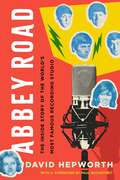- Table View
- List View
A is for Oboe: The Orchestra's Alphabet
by Marilyn Nelson Lera AuerbachThis deeply imaginative and entertaining poetry collection details the pleasures of the orchestra, from strong-willed A to satisfied Z.Two widely acclaimed poets--one a composer and classical pianist as well--have come together to create this extraordinary portrait of the orchestra in all of its richness and fascination, using the structure of the alphabet in a way that's entirely new and delightful. A is for the first note you hear as you take your seat in the concert hall, played by the headstrong oboe. B is for the bassoon, "the orchestra's jester, complaining impatiently through his nose." And C is for the conductor, "like the captain on the bridge of a great ship, navigating the composer's musical charts." Onward the text goes, soaring in reverie and making thought-provoking observations while not taking itself too seriously--illuminating all the various details that flow together to create the nourishing experience of playing or listening to music.
A través de los ojos
by Andrés SuárezEl lado más íntimo de uno de los cantautores del momento: un homenaje a la vida a través de los ojos de todas las personas y lugares que lo rodean. Andrés Suárez vuelve con un libro de relatos que desgranan su lado más intimista y poético, para revolucionar el mundo que ha creado con sus letras musicales. Tras el éxito de Más allá de mis canciones, regresa con esta compilación de cápsulas que tocan el corazón, contadas bajo el prisma de diversas miradas: la de un niño, la de una camarera, la de un gran amigo que ya no está o la de los fuegos artificiales de Cedeira. A través de los ojos es un canto a la amistad, a la solidaridad, a la infancia y a la inocencia: un viaje al pasado en homenaje a los días vividos.
A través del vaso: En vivo con 26 músicas y músicos de México
by Mariana H26 entrevistas con algunos de los protagonistas del rock y la música popular en nuestro país. Este libro contiene rock, hip hop, pop, son huasteco, metal, música experimental, un par de boleros y una polca. Contiene 26 voces en vivo de los y las protagonistas de la escena musical mexicana, de las autoras y autores de algunos de los himnos de nuestras patrias emocionales. Amandititita, Abulón, Lino Nava, Fernando Rivera Calderón, Cecilia Toussaint, Dr. Shenka, Ely Guerra, José Manuel Aguilera, Jay de la Cueva, Denise Gutiérrez, Paco Huidobro, Jaime López, Tammy Tamerlane, Tito Fuentes, Clemente Castillo, Pato Machete, Natalia Lafourcade, Joselo Rangel, Jessy Bulbo, Daniel Gutiérrez, Chema Arreola, Pepe Mogt, Silverio, Sergio Arau, Sabo Romo, Ximena Sariñana.
A veces llegan cartas: La Gramola
by Joaquín Guzmán¿Quién, alguna vez en la vida, no ha depositado en una canción sueños, alegrías, tristezas? ¿Quién no se ha dejado llevar por la melancolía al escuchar una letra o ha hecho de unos compases el símbolo de su existencia? La música nos conecta con lo más profundo de nosotros mismos, y eso lo sabe bien Joaquín Guzmán, quien, al frente de La Gramola desde hace más de seis años, ha establecido un duradero lazo de amistad y confidencias con sus miles de oyentes. Este libro recoge algunas de las miles de cartas que a lo largo de los años han llegado a La Gramola. Algunas son estremecedoras, y nos muestran que un programa de radio puede ser un asidero a la vida; otras están marcadas por el sentido del humor, narran pequeñas historias personales... Todas son sinceras, emotivas, y nos descubren un universo íntimo y humano. A veces llegan cartas es un homenaje a todas esas personas que unavez se atrevieron a escribir de sí mismos.
A&R Pioneers: Architects of American Roots Music on Record (Co-published with the Country Music Foundation Press)
by Brian Ward Patrick HuberA&R Pioneers offers the first comprehensive account of the diverse group of men and women who pioneered artists-and-repertoire (A&R) work in the early US recording industry. In the process, they helped create much of what we now think of as American roots music. Resourceful, innovative, and, at times, shockingly unscrupulous, they scouted and signed many of the singers and musicians who came to define American roots music between the two world wars. They also shaped the repertoires and musical styles of their discoveries, supervised recording sessions, and then devised marketing campaigns to sell the resulting records. By World War II, they had helped redefine the canons of American popular music and established the basic structure and practices of the modern recording industry. Moreover, though their musical interests, talents, and sensibilities varied enormously, these A&R pioneers created the template for the job that would subsequently become known as "record producer."Without Ralph Peer, Art Satherley, Frank Walker, Polk C. Brockman, Eli Oberstein, Don Law, Lester Melrose, J. Mayo Williams, John Hammond, Helen Oakley Dance, and a whole army of lesser known but often hugely influential A&R representatives, the music of Bessie Smith and Bob Wills, of the Carter Family and Count Basie, of Robert Johnson and Jimmie Rodgers may never have found its way onto commercial records and into the heart of America's musical heritage. This is their story.
A&R Pioneers: Architects of American Roots Music on Record (Co-published with the Country Music Foundation Press)
by Brian Ward Patrick HuberAssociation for Recorded Sound Collections Certificate of Merit for the Best Historical Research in Recorded Roots or World Music, 2019A&R Pioneers offers the first comprehensive account of the diverse group of men and women who pioneered artists-and-repertoire (A&R) work in the early US recording industry. In the process, they helped create much of what we now think of as American roots music. Resourceful, innovative, and, at times, shockingly unscrupulous, they scouted and signed many of the singers and musicians who came to define American roots music between the two world wars. They also shaped the repertoires and musical styles of their discoveries, supervised recording sessions, and then devised marketing campaigns to sell the resulting records. By World War II, they had helped redefine the canons of American popular music and established the basic structure and practices of the modern recording industry. Moreover, though their musical interests, talents, and sensibilities varied enormously, these A&R pioneers created the template for the job that would subsequently become known as "record producer." Without Ralph Peer, Art Satherley, Frank Walker, Polk C. Brockman, Eli Oberstein, Don Law, Lester Melrose, J. Mayo Williams, John Hammond, Helen Oakley Dance, and a whole army of lesser known but often hugely influential A&R representatives, the music of Bessie Smith and Bob Wills, of the Carter Family and Count Basie, of Robert Johnson and Jimmie Rodgers may never have found its way onto commercial records and into the heart of America's musical heritage. This is their story.
A(l)ma libre
by Lidia RauetA(l)ma libre es el primer instapoemario de Lidia Rauet. Un libro de reflexiones y poemas a través de los cuales podrás conocer mejor el mundo de Lidia. Fui tan frágil como un cristal a punto de estallar.Aprendí a estar sola, y eso me hizo no volver a estarlo nunca más.Descubrí en mi misma el impulso que nos da alas para volar. Amarme a mí misma fue el principio de esta historia.Estás a punto de conocer mis miedos, mis barreras, mis logros.Estás a punto de descubrir mi verdad.
AC/DC: Hell Ain't a Bad Place to Be
by Mick WallMick Wall penetrates the closed world of Aussie rock legends AC/DC.AC/DC moved to Britain from Sydney in 1975, and soon set up a residency at London's Marquee Club. Their short hair (including the odd mullet), loud rock and attitude chimed well with the lingering pub rock and soon-to-be punk crowd. They weren't really a band for guitar solos, and singer Bon Scott was the original bike-riding, speed-snorting, fighting man. An ex-convict he lived life fast and short; he died in February 1980, just before BACK IN BLACK, their huge-selling album, took off and the second period of AC/DC (with Brian Johnson as lead vocalist) was ushered in. BACK IN BLACK has gone on to sell 45 million copies worldwide, and as the band have become a global phenomenon so their reclusiveness has increased. Mick Wall, the don of heavy metal writing, seeks to penetrate the wall around the Young brothers, and write the first authoritative, in-depth critical account of AC/DC.
AC/DC: Hell Ain't a Bad Place to Be
by Mick WallMick Wall penetrates the closed world of Aussie rock legends AC/DC.AC/DC moved to Britain from Sydney in 1975, and soon set up a residency at London's Marquee Club. Their short hair (including the odd mullet), loud rock and attitude chimed well with the lingering pub rock and soon-to-be punk crowd. They weren't really a band for guitar solos, and singer Bon Scott was the original bike-riding, speed-snorting, fighting man. An ex-convict he lived life fast and short; he died in February 1980, just before BACK IN BLACK, their huge-selling album, took off and the second period of AC/DC (with Brian Johnson as lead vocalist) was ushered in. BACK IN BLACK has gone on to sell 45 million copies worldwide, and as the band have become a global phenomenon so their reclusiveness has increased. Mick Wall, the don of heavy metal writing, seeks to penetrate the wall around the Young brothers, and write the first authoritative, in-depth critical account of AC/DC.
AC/DC: High-Voltage Rock 'n' Roll: The Ultimate Illustrated History
by Phil SutcliffeFormed in 1973 by brothers Angus and Malcolm Young, AC/DC has become one of the most popular rock ’n’ roll bands in history. This massive new title follows the band from its roots in Sydney, Australia, to its most recent releases and sold-out world tours. No stone is left unturned, from the AC/DC’s formation and early club gigs to its astounding worldwide success. A special cover incorporating Angus on a spinning disc gives way to more than 400 illustrations include handbills, posters, backstage passes, and vinyl from around the globe, as well as rare candid and performance photography. Sidebars from top rock scribes examine all studio releases and delve into the guitar gear of the Young brothers. The result is an awesome tribute to the band renowned for a live-wire stage show and a sonic attack that have attracted fans from all rock camps Contributors include: Phil Sutcliffe Joe Bonomo Danie Bukszpan Jen Jewel Brown Anthony Bozza Garth Cartwright Ian Christe David Dunlap Andrew Earles Dave Hunter James McNair Martin Popoff Sylvie Simmons Bill Voccia
AC/DC: The Ultimate Story of the World's Greatest Rock and Roll Band
by Murray Engleheart Arnaud DurieuxOver three decades and more than 150 million albums, AC/DC has established itself as much more than just a great rock band. For millions of fans spanning several generations across the world, they are an ear-bleedingly loud, sweat-soaked religion, courtesy of such classic albums as Highway to Hell and Back in Black.Now, in a book of astonishing breadth and scope, comes, for the very first time, the complete story of AC/DC. Everything you ever wanted to know and plenty more you never dreamt of is all here, the ultimate balls-out adventure, laced with sex, drunken escapades and brawls. It's a journey that started in the suburban Sydney, Australia, bedrooms of brothers Malcolm and Angus Young, boys who could wreak havoc with their guitars. Over their power chords were the lyrics and voice of Bon Scott, who would lead them higher and higher—until his tragic death in 1980. The bittersweet irony after his death was that not only did the Youngs manage to hold together without him, but the band's fortunes and status skyrocketed with his replacement, Brian Johnson, and the album Back in Black.Five long years in the making, AC/DC: Maximum Rock & Roll is sourced from more than 1,300 interviews the band has given over the past thirty years combined with in excess of 75 of the authors' own interviews with those who worked with AC/DC both in the studio and on the road—many of whom have never spoken about the band publicly. It's topped off with stunning, never-before-seen photos to create the ultimate portrait of the ultimate rock band.
AC/DC: The World's Heaviest Rock
by Martin HuxleyOver the decades, AC/DC has carved out a unique niche in the rock world. Thanks to their stubborn refusal to alter their aggressive, in-your-face style that has been their stock in trade, they have emerged as one of the essential cornerstones of contemporary hard rock. Frank, humorous, and accurate, this full-blooded biography takes a look this tenacious Australian quintet.
ACT for Musicians: A Guide for Using Acceptance and Commitment Training to Enhance Performance, Overcome Performance Anxiety, and Improve Well-Being
by David G. JuncosWhile it is widely recognized that music contributes to the health and well-being of societies, the reverse is not necessarily true. Being a professional musician is a rewarding yet challenging occupation, and the results of newer survey studies show musi
AI and the Music Industry: Transforming Production, Platforms, and Practice
by Richard Boateng Sheena Lovia Boateng Joseph BuduIn recent years, the profound impact of artificial intelligence (AI) on fostering new forms of entrepreneurship has become increasingly evident. Entrepreneurs worldwide are harnessing the capabilities of AI to develop innovative solutions and create businesses that address pressing challenges.Despite the growing recognition of AI’s potential, there exists a crucial need to deepen understanding and awareness surrounding how individuals are leveraging AI to establish novel ventures. Many entrepreneurs are pioneering initiatives that deploy AI technologies to tackle complex problems. This challenge revolves around the imperative to explore, document, and comprehend the diverse ways in which AI is driving the emergence of new businesses, solving real-world problems, and reshaping the entrepreneurial landscape. It underscores the necessity for entrepreneurs, researchers, and the wider community to grasp the transformative role of AI in fostering innovation and enabling the creation of businesses dedicated to addressing societal issues. Addressing this challenge will contribute to a more comprehensive understanding of the synergy between AI and entrepreneurship, paving the way for informed and impactful ventures that leverage the full potential of AI technologies.This book delves into the transformative impacts of AI on the music industry. It reviews trends in digital platforms and music research, the integration of AI in music production, and the experiences of artists and music publishers using AI. It presents a comparative analysis of AI adoption patterns in the music industry and provides practical insights into the use of AI tools for music production and distribution. Additionally, it offers a detailed syllabus for training music industry stakeholders on harnessing AI technologies, illustrating the significant role AI plays in shaping the future of music.
AI for Arts (AI for Everything)
by Niklas Hageback Daniel HedblomAI for Arts is a book for anyone fascinated by the man–machine connection, an unstoppable evolution that is intertwining us with technology in an ever-greater degree, and where there is an increasing concern that it will be technology that comes out on top. Thus, presented here through perhaps its most esoteric form, namely art, this unfolding conundrum is brought to its apex. What is left of us humans if artificial intelligence also surpasses us when it comes to art? The articulation of an artificial intelligence art manifesto is long overdue, so hopefully this book can fill a gap that will have repercussions not only for aesthetic and philosophical considerations but possibly more so for the development of artificial intelligence.
ASHÉ: Ritual Poetics in African Diasporic Expression (Routledge Advances in Theatre & Performance Studies)
by Michael D. Harris Paul Carter Harrison Pellom McDaniels III‘ASHÉ: Ritual Poetics in African Diasporic Expressivity' is a collection of interdisciplinary essays contributed by international scholars and practitioners. Having distinguished themselves across such disciplines as Anthropology, Art, Music, Literature, Dance, Philosophy, Religion, and Theology and conjoined to construct a defining approach to the study of Aesthetics throughout the African Diaspora with the Humanities at the core, this collection of essays will break new ground in the study of Black Aesthetics. This book will be of great interest to scholars, practitioners, and students interested in tracing African heritage identities throughout the African Diaspora through close examination of a variety of discourses directly connected to expressive elements of cultural production and religious rituals.
Aaron Copland in Latin America: Music and Cultural Politics (Music in American Life)
by Carol A. HessBetween 1941 and 1963, Aaron Copland made four government-sponsored tours of Latin America that drew extensive attention at home and abroad. Interviews with eyewitnesses, previously untapped Latin American press accounts, and Copland’s diaries inform Carol A. Hess’s in-depth examination of the composer’s approach to cultural diplomacy. As Hess shows, Copland’s tours facilitated an exchange of music and ideas with Latin American composers while capturing the tenor of United States diplomatic efforts at various points in history. In Latin America, Copland’s introduced works by U.S. composers (including himself) through lectures, radio broadcasts, live performance, and conversations. Back at home, he used his celebrity to draw attention to regional composers he admired. Hess’s focus on Latin America’s reception of Copland provides a variety of outside perspectives on the composer and his mission. She also teases out the broader meanings behind reviews of Copland and examines his critics in the context of their backgrounds, training, aesthetics, and politics.
Aaron Copland: A Guide to Research (Routledge Music Bibliographies)
by Marta Robertson Robin ArmstrongAaron Copland (1900-1990) is generally considered the most popular and well-known composer of American art music, and yet little scholarly attention has been paid to Copland since the 1950s. This volume begins with a portrait of the composer and an evaluation of significant research trends which is intended to fill a void and to suggest directions for further research. The guide also provides a section discussing Copland's interdisciplinary interests, such as ballet and film work, as well as a comprehensive bibliography of writings about Copland and his music.
Aaron Copland: A Reader: Selected Writings, 1923-1972
by Richard Kostelanetz Steve SilversteinThis book presents a selection of the best writings, of the American composer and music legend Aaron Copland, on a wide variety of topics. It features excerpts from his correspondence and recommendations he wrote for other composers.
Aaron Copland: The Life and Work of an Uncommon Man
by Howard PollackDefinitive biography of Aaron Copland. Copious names, places & dates. Must have familiarity with 20th century art and music. A must read for Copland fans.
Aaron Copland: The Life and Work of an Uncommon Man
by Howard PollackA candid and fascinating portrait of the American composer. The son of Russian-Jewish immigrants, Aaron Copland (1900-1990) became one of America's most beloved and esteemed composers. His work, which includes Fanfare for the Common Man, A Lincoln Portrait, and Appalachian Spring, has been honored by a huge following of devoted listeners. But the full richness of Copland's life and accomplishments has never, until now, been documented or understood. Howard Pollack's meticulously researched and engrossing biography explores the symphony of Copland's life: his childhood in Brooklyn; his homosexuality; Paris in the early 1920s; the Alfred Stieglitz circle; his experimentation with jazz; the communist witch trials; Hollywood in the forties; public disappointment with his later, intellectual work; and his struggle with Alzheimer's disease. Furthermore, Pollack presents informed discussions of Copland's music, explaining and clarifying its newness and originality, its aesthetic and social aspects, its distinctive and enduring personality."Not only a success in its own right, but a valuable model of what biography can and probably should be. " - Kirkus Reviews
Aaron Jay Kernis
by Leta E. MillerWinner of both the Pulitzer Prize and the Grawemeyer Award, Aaron Jay Kernis achieved recognition as one of the leading composers of his generation while still in his thirties. Since then his eloquent yet accessible style, emphasis on melody, and willingness to engage popular as well as classical forms has brought him widespread acclaim and admiring audiences. Leta Miller's biography offers the first survey of the composer's life and work. Immersed in music by middle school, and later training under Theodore Antoniou, John Adams, Jacob Druckman, and others, Kernis rejected the idea of distancing his work from worldly concerns and dared to compose on political themes. His Second Symphony, from 1991, engaged with the first Gulf War; 1993's Still Moment with Hymn was a reaction to the Bosnian Genocide; and the next year's Colored Field and 1995's Lament and Prayer dealt with the Holocaust. Yet Kernis also used sources as disparate as futurist agitprop and children's games to display humor in his work. Miller's analysis addresses not only Kernis's wide range of subjects but also the eclecticism that has baffled critics, analyzing his dedication to synthesis and the themes consistent in his work. Informed and engaging, Aaron Jay Kernis gives a rare mid-career portrait of a major American cultural figure.
Abba: The Story Behind Every Track
by Benoît ClercTHE DEFINITIVE RECORDING HISTORY OF SWEDISH SUPERSTARS, ABBA, TOLD ALBUM-BY-ALBUM AND SONG-BY-SONG.Filled with fascinating photography (some rarely seen) and sensational behind-the-scenes details.Discover the untold stories behind ABBA's greatest hits, including the iconic 'Waterloo', 'Mamma Mia' and 'Dancing Queen' in this loving and thorough dissection of every album and song released by the pop megastars. From their first single in 1972, all the way up to their Grammy-nominated studio album, Voyage, and their revolutionary virtual tour, this definitive tome uncovers the full story behind every track that ABBA released.In over 500 pages, no stone is left unturned. Drawing upon decades of research, expert author Benoît Clerc recounts the circumstances that led to the composition of every song - detailing the inspiration behind the lyrics, the recording process and the instruments that shaped ABBA's distinctive sound.Featuring hundreds of photographs, including rare publicity stills, images of the instruments used by the band, and shots of the musicians on-stage and in-studio, Abba: All the Songs is the perfect gift for any fan of pop.
Abba: The Story Behind Every Track
by Benoît ClercTHE DEFINITIVE RECORDING HISTORY OF SWEDISH SUPERSTARS, ABBA, TOLD ALBUM-BY-ALBUM AND SONG-BY-SONG.Filled with fascinating photography (some rarely seen) and sensational behind-the-scenes details.Discover the untold stories behind ABBA's greatest hits, including the iconic 'Waterloo', 'Mamma Mia' and 'Dancing Queen' in this loving and thorough dissection of every album and song released by the pop megastars. From their first single in 1972, all the way up to their Grammy-nominated studio album, Voyage, and their revolutionary virtual tour, this definitive tome uncovers the full story behind every track that ABBA released.In over 500 pages, no stone is left unturned. Drawing upon decades of research, expert author Benoît Clerc recounts the circumstances that led to the composition of every song - detailing the inspiration behind the lyrics, the recording process and the instruments that shaped ABBA's distinctive sound.Featuring hundreds of photographs, including rare publicity stills, images of the instruments used by the band, and shots of the musicians on-stage and in-studio, Abba: All the Songs is the perfect gift for any fan of pop.
Abbey Road: The Inside Story of the World's Most Famous Recording Studio
by David HepworthThe incredible history of how Abbey Road became the most famous recording studio in the world. "There are certain things that are mythical. Abbey Road is mythical."—Nile Rodgers Many people will recognize the famous crosswalk. Some visitors may have graffitied their name on its hallowed outer walls. Others might even have managed to penetrate the iron gates. But what draws in these thousands of fans here, year after year? What is it that really happens behind the doors of the most celebrated recording studio in the world? It may have begun life as an affluent suburban house, but it soon became a creative hub renowned around the world as a place where great music, ground-breaking sounds, and unforgettable tunes were forged. It is nothing less than a witness to, and a key participant in, the history of popular music itself. What has been going on there for over ninety years has called for skills that are musical, creative, technical, mechanical, interpersonal, logistical, managerial, chemical and, romantics might be tempted add, close to magic. The history of Abbey Road may just make you believe.
